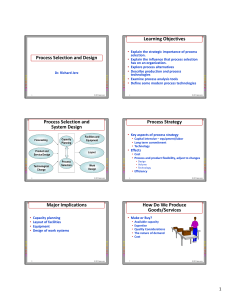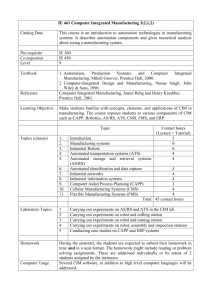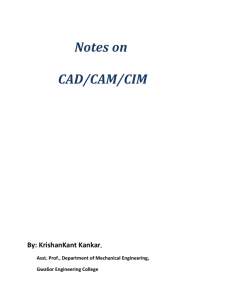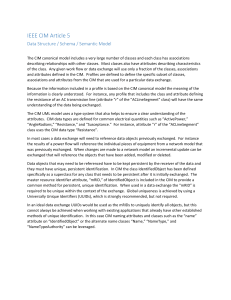Computer Integrated Manufacturing Detailed Outline
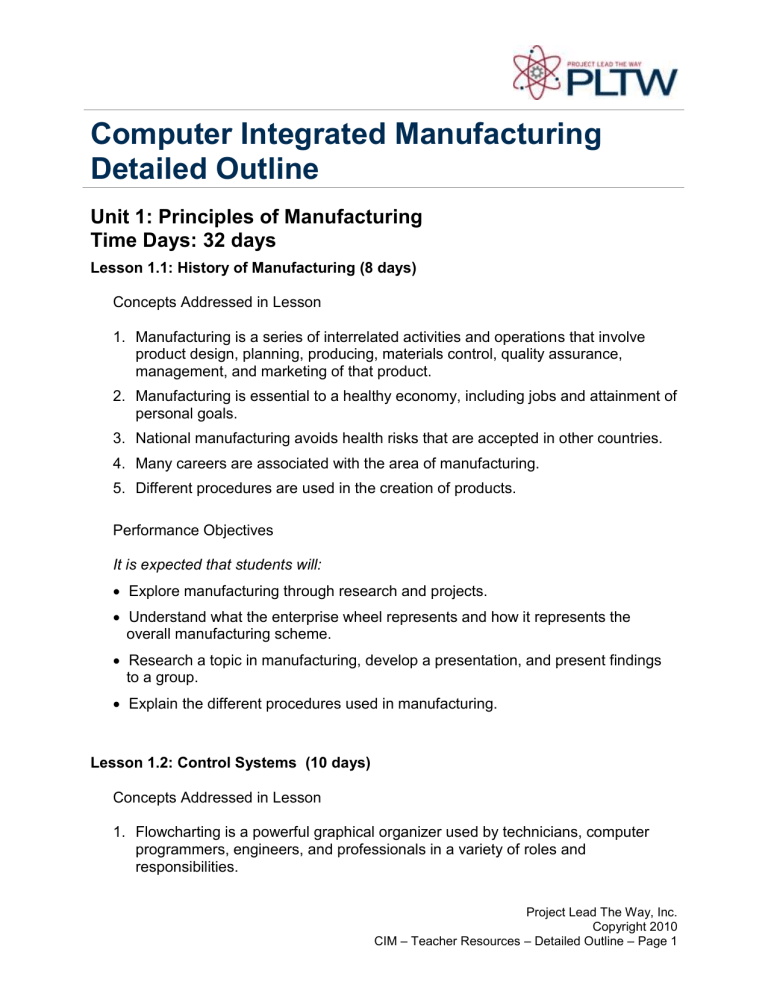
Computer Integrated Manufacturing
Detailed Outline
Unit 1: Principles of Manufacturing
Time Days: 32 days
Lesson 1.1: History of Manufacturing (8 days)
Concepts Addressed in Lesson
1. Manufacturing is a series of interrelated activities and operations that involve product design, planning, producing, materials control, quality assurance, management, and marketing of that product.
2. Manufacturing is essential to a healthy economy, including jobs and attainment of personal goals.
3. National manufacturing avoids health risks that are accepted in other countries.
4. Many careers are associated with the area of manufacturing.
5. Different procedures are used in the creation of products.
Performance Objectives
It is expected that students will:
Explore manufacturing through research and projects.
Understand what the enterprise wheel represents and how it represents the overall manufacturing scheme.
Research a topic in manufacturing, develop a presentation, and present findings to a group.
Explain the different procedures used in manufacturing.
Lesson 1.2: Control Systems (10 days)
Concepts Addressed in Lesson
1. Flowcharting is a powerful graphical organizer used by technicians, computer programmers, engineers, and professionals in a variety of roles and responsibilities.
Project Lead The Way, Inc.
Copyright 2010
CIM – Teacher Resources – Detailed Outline – Page 1
2. During the design and development process, flowcharting is used to plan and depict the process flow for an entire system and all of its subsystems.
3. Computer programmers use flowcharting symbols to graphically organize the flow of program control, including all inputs, outputs, and conditions that may occur.
4. Everyday products including cars, microwaves, ovens, hair dryers, coffee pots, and washing machines all use control systems to manage their operation.
Performance Objectives
It is expected that students will:
Identify basic flowcharting symbols and discuss their functions.
Create a flowchart that portrays a manufacturing process.
Apply flowcharting to areas other than manufacturing.
Identify a control system and explain its application to manufacturing.
Model and create a program to control an automated system.
Lesson 1.3: The Cost of Manufacturing (14 days)
Concepts Addressed in Lesson
1. When designing a control system, cost and safety are two key factors that must be considered.
2. Many factors come into play when calculating the cost of manufacturing a product.
3. Tradeoffs may be made between hiring highly skilled or experienced workers and keeping costs down.
4. The less time a part takes to make, the more potential profit is available.
5. Long term planning and investments may cost more up front but may provide additional savings in the future.
Performance Objectives
It is expected that students will:
Create a control system that replicates a factory cell.
Maximize the efficiency of the manufacturing system with respect to time and cost.
Compare the efficiency of running multiple systems against that of one large system.
Project Lead The Way, Inc.
Copyright 2010
CIM – Teacher Resources – Detailed Outline – Page 2
Unit 2: Manufacturing Processes
Time Days: 54 days
Lesson 2.1: Designing for Manufacturability (10 days)
Concepts Addressed in Lesson
1. Design is a process that is used to systematically solve problems.
2. Many considerations must be made when manufacturing a quality part.
3. Material properties must be considered as part of the design process.
4. Manufacturers have an ethical responsibility to create safe products and to provide a safe work environment.
5. Manufacturers have a legal responsibility to provide safety information about their products.
6. Many engineering disciplines have a code of conduct or code of ethics that their members are expected to follow.
7. Analyzing case studies of engineering failures is a good way for engineers to avoid future failures.
Performance Objectives
It is expected that students will:
Use the design process.
Use knowledge of design to analyze products with flaws.
Use calculated volume, mass, surface area of parts to determine material cost, waste, and packaging requirements.
Use solid modeling software to improve a flawed design.
Determine whether a product is safe for a given audience (e.g., children under the age of three).
Make ethical decisions about manufacturing.
Create a product using solid modeling software.
Lesson 2.2: How We Make Things (6 days)
Concepts Addressed in Lesson
1. Prototyping is part of a design process where a physical model can be evaluated to refine the design.
2. Before raw material can be used in manufacturing, it must undergo primary processing.
Project Lead The Way, Inc.
Copyright 2010
CIM – Teacher Resources – Detailed Outline – Page 3
3. The separating process is one of the oldest manufacturing processes.
4. Milling and shearing utilize the subtractive process to create products.
5. ECM, EDM, water-, and laser-cutting are using newer technologies to enhance the accuracy and efficiency of material removal.
6. Metals, plastics, and ceramics are types of materials that are well suited to the manufacturing process.
7. The way in which a product is made is dependent upon the properties of the material that will be used.
Performance Objectives
It is expected that students will:
Explain the difference between primary and secondary manufacturing processes.
Analyze a product to propose the manufacturing processes used to create it.
Explore manufacturing processes via research.
Explore prototyping processes.
Lesson 2.3: Product Development (38 days)
Concepts Addressed in Lesson
1. Many machines exist to perform manufacturing processes.
2. Machine code is an essential tool used to communicate with some machines.
3. Jigs and fixtures are essential in maintaining consistency and quality control.
4. Computer Aided Manufacturing (CAM) programming tools make it possible to manufacture physical models using Computer Aided Design (CAD) programs.
5. Products manufactured today have been greatly influenced by the advancement of machines and technology.
6. Several variables in machining operations affect the final product in manufacturing.
7. Profit margins are essential to a company’s survival in a competitive market.
8. Prototyping is a major step in the design cycle of manufactured goods and has been greatly advanced with the advent and use of rapid prototyping processes.
Performance Objectives
It is expected that students will:
Project Lead The Way, Inc.
Copyright 2010
CIM – Teacher Resources – Detailed Outline – Page 4
Identify machines when given a process and identify the process that a given machine performs.
Determine the appropriate speed rate for a given material using a tool with a given diameter.
Determine the feed rate for a given material using a tool with a given diameter.
Read and interpret G & M codes.
Transfer the drawings made in CAD to a CAM program.
Create numerical code using a CAM program.
Verify the creation of a part using a simulation software.
Create parts using the machines demonstrated by the instructor.
Create a product on the computer using knowledge of manufacturing processes.
Unit 3: Elements of Automation
Time Days: 46 days
Lesson 3.1: Introduction to Automation (19 Days)
Concepts Addressed in Lesson
1. Many factors have influenced the evolution of automation.
2. A variety of automation careers exist.
3. Robots are widely used in industry to assist in the production of manufactured goods.
4. Robots have distinct advantages over humans in some industrial settings (e.g., hazardous environments, repetitive motion or long hours).
5. Robots and machines communicate and coordinate their activities through a process called handshaking.
Performance Objectives
It is expected that students will:
Research a topic in automation.
Explore automation careers.
Identify the advantages and disadvantages of robotic labor versus human labor.
Explore materials handling.
Create and program virtual robotic work cells with simulation software.
Project Lead The Way, Inc.
Copyright 2010
CIM – Teacher Resources – Detailed Outline – Page 5
Program the interface between a robot and another machine.
Lesson 3.2: Elements of Power (10 Days)
Concepts Addressed in Lesson
1. Power is produced in many ways and transmitted through various forms (e.g. electrical, pneumatic, hydraulic, and motion).
2. Fluid power is inversely proportional to the area upon which the force is being applied.
3. Sensors provide feedback to control systems and products used by consumers.
4. Pneumatics is one form of fluid power that can be used to operate machines and products.
Performance Objectives
It is expected that students will:
Identify the three main power types.
Solve problems involving electrical, pneumatic, and mechanical power.
Convert power between units.
Calculate torque and use it to calculate power.
Solve problems involving fluid power.
Construct a system to convert pneumatic power into mechanical power.
Lesson 3.3: Robotic Programming and Usage (17 Days)
Concepts Addressed in Lesson
1. Basic programming skills include variable declaration, loops, and debugging.
2. A variety of robots and unique programming languages are used in the manufacturing industry.
3. Many everyday products use microcontrollers.
4. Robots are used to perform diverse functions and work in diverse environments.
5. The size of a robot is based on the work envelope and payload needed to perform the task.
Performance Objectives
It is expected that students will:
Build the Lynxmotion robot if the robots are not already built.
Project Lead The Way, Inc.
Copyright 2010
CIM – Teacher Resources – Detailed Outline – Page 6
Learn the programming language needed to operate the Lynx robot.
Create programs using robotic software that will allow the robot to perform a set of tasks.
Configure servo motors to operate the Lynxmotion robot.
Formulate a list of tasks in which the robot used in class can be used in a large scale CIM cell operation.
Unit 4: Integration of Manufacturing Elements
Time: 47 Days
Lesson 4.1: Integration of Manufacturing Elements (10 Days)
Concepts Addressed in Lesson
1. The process of mass production is used when the same product is created repeatedly.
2. A workcell is a group of machines in which each individual machine has its own specialty.
3. A flexible manufacturing system is one that can adapt to a wide variety of products.
4. Tradeoffs are made when one system is utilized over another.
5. Process flow design has a major impact on overall production time and product profit.
6. During the design and development process, flowcharting is used to plan and depict the detailed process flow for an entire system and all of its subsystems.
7. Flowcharting can be used to illustrate the phases of the product development process.
8. Manufacturing and automation careers are varied in scope and location.
Performance Objectives
It is expected that students will:
Identify the three categories of CIM systems.
Compare and contrast the benefits and drawbacks of the three categories of
CIM systems.
Identify the components of a FMS.
Create a process design chart for a manufacturing process.
Explore a manufacturing or automation career of interest and determine the appropriateness and steps required to be a professional in that role.
Project Lead The Way, Inc.
Copyright 2010
CIM – Teacher Resources – Detailed Outline – Page 7
Lesson 4.2: Manufacturing Application (37 Days)
Concepts Addressed in Lesson
1. Process flow design has a major impact on overall production time and product profit.
2. During the design and development process, flowcharting is used to plan and depict the detailed process flow for an entire system as well as all of its subsystems.
3. Flowcharting can be used to illustrate the overall phases of the product development process.
4. Safe operating procedures must be addressed in a CIM environment at all times to avoid serious injury.
5. Tradeoffs occur between efficiency and cost when choosing a manufacturing system.
6. Engineers choose appropriate sensors to ensure high quality part production.
7. Proper sequencing of automated operations is important in factory design.
8. Identification of correct electrical and fluid power systems is required to complete the desired manufacturing system.
Performance Objectives
It is expected that students will:
Identify the potential safety issues with a CIM system and identify solutions for these problems.
Understand the significance of teamwork and communication.
Design a manufacturing system that contains at least two automated components.
Complete the construction of each individual component of the miniature FMS and verify that each component works.
Assemble components into a working miniature FMS.
Refine each component to improve the total process flow and cycle time.
Start and maintain a journal that documents daily work.
Project Lead The Way, Inc.
Copyright 2010
CIM – Teacher Resources – Detailed Outline – Page 8

